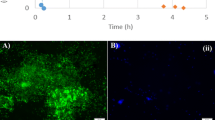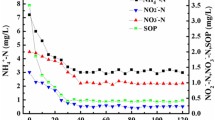Abstract
The use of saline water in urban areas for non-potable purposes to cope with fresh water scarcity, intrusion of saline water, and disposal of industrial saline wastewater into the sewerage lead to elevated salinity levels in wastewaters. Consequently, saline wastewater is generated, which needs to be treated before its discharge into surface water bodies. The objective of this research was to study the effects of salinity on the aerobic metabolism of phosphate-accumulating organisms (PAO), which belong to the microbial populations responsible for enhanced biological phosphorus removal (EBPR) in activated sludge systems. In this study, the short-term impact (hours) of salinity (as NaCl) was assessed on the aerobic metabolism of a PAO culture, enriched in a sequencing batch reactor (SBR). All aerobic PAO metabolic processes were drastically affected by elevated salinity concentrations. The aerobic maintenance energy requirement increased, when the salinity concentration rose up to a threshold concentration of 2 % salinity (on a W/V basis as NaCl), while above this concentration, the maintenance energy requirements seemed to decrease. All initial rates were affected by salinity, with the NH4- and PO4-uptake rates being the most sensitive. A salinity increase from 0 to 0.18 % caused a 25, 46, and 63 % inhibition of the O2, PO4, and NH4-uptake rates. The stoichiometric ratios of the aerobic conversions confirmed that growth was the process with the highest inhibition, followed by poly-P and glycogen formation. The study indicates that shock loads of 0.18 % salt, which corresponds to the use or intrusion of about 5 % seawater may severely affect the EBPR process already in wastewater treatment plants not exposed regularly to high salinity concentrations.





Similar content being viewed by others
References
APHA (1995) Standard Methods for the Examination of Water and Wastewater, 19th edn. American Public Health Association, Washington
Bassin JP, Pronk M, Muyzer G, Kleerebezem R, Dezotti M, Van Loosdrecht MCM (2011) Effect of elevated salt concentrations on the aerobic granular sludge process: linking microbial activity with microbial community structure. Appl Environ Microbiol 77(22):7942–7953
Brdjanovic D, van Loosdrecht MCM, Hooijmans CM, Alaerts GJ, Heijnen JJ (1997) Temperature effects on physiology of biological phosphrorus removal. ASCE J Environ Eng-ASCE 123(2):144–154
Carvalho G, Lemos PC, Oehmen A, Reis MAM (2007) Denitrifying phosphorus removal: linking the process performance with the microbial community structure. Water Res 41:4383–4396
Castle AM, Macnab RM, Shulman RG (1986) Coupling between the sodium and proton gradients in respiring Escherichia coli cells measured by 23Na and 31P nuclear magnetic resonance. J Biol Chem 261(17):7797–7806
Cui Y, Peng C, Peng Y, Ye L (2009) Effects of salt on microbial populations and treatment performance in purifying saline sewage using the MUCT process. Clean-Soil Air Water 37(8):649–656
Fahim FA, Fleita DH, Ibrahim AM, El-Dars FMS (2000) Evaluation of some methods for fish canning wastewater treatment. Water Air Soil Pollut 127:205–226
Flowers JJ, He S, Yilmaz S, Noguera DR, McMahon KD (2009) Denitrification capabilities of two biological phosphorus removal sludges dominated by different ‘Candidatus Accumulibacter’ clades. Environ Microbiol Rep 1(6):583–588
Gonzalez JF, Civit EM, Lupin HM (1983) Composition of fish filleting wastewater. Water SA 9(2):49–56
Hong CC, Chan SK, Shim H (2007) Effect of chloride on biological nutrient removal from wastewater. J Appl Sci Environ Sanit 2(3):85–92
Intrasungkha N, Keller J, Blackall LL (1999) Biological nutrient removal efficiency in treatment of saline wastewater. Water Sci Technol 39(6):183–190
Kargi F, Uygur A (2005) Improved nutrient removal from saline wastewater in an SBR by halobacter supplemented activated sludge. Environ Eng Sci 22(2):170–176
Lazarova V, Hills S, Birks R (2003) Using recycled water for non-potable, urban uses: a review with particular reference to toilet flushing. Water Sci Technol 3(4):69–77
Lefebvre O, Moletta R (2006) Treatment of organic pollution in industrial saline wastewater: a literature review. Water Res 40:3671–3682
Leung RWK, Li DCH, Yu WK, Chui HK, Lee TO, Van Loosdrecht MCM, Chen GH (2012) Integration of seawater and grey water reuse to maximize alternative water resource for coastal areas: the case of the Hong Kong international airport. Water Sci Technol 65(3):410–417
Lopez C, Pons MN, Morgenroth E (2006) Endogenous processes during long-term starvation in activated sludge performing enhanced biological phosphorus removal. Water Res 40(8):1519–1530
Lopez-Vazquez CM, Song YI, Hooijmans CM, Brdjanovic D, Moussa MS, Gijzen HJ, van Loosdrecht MCM (2008) Temperature effects on the aerobic metabolism of Glycogen- Accumulating Organisms. Biotechnol Bioeng 101(2):295–306
Lu H, Keller J, Yuan Z (2007) Endogenous metabolism of Candidatus Accumulibacter phosphatis under various starvation conditions. Water Res 41(20):4646–4656
Mesple F, Troussellier M, Casellas C, Legendre P (1996) Evaluation of simple statistical criteria to qualify a simulation. Ecol Model 88(1–3):9–18
Oehmen A, Zeng R, Keller J, Yuan Z (2007) Modeling the aerobic metabolism of polyphosphate-accumulating organisms enriched with propionate as a carbon source. Water Environ Res 79(13):2477–2486
Orhon D, Tasli R, Sozen S (1999) Experimental basis of activated sludge treatment for industrial wastewaters—the state of the art. Water Sci Technol 40(1):1–11
Panswad T, Anan C (1999) Impact of high chloride wastewater on an anaerobic/anoxic/aerobic process with and without inoculation of chloride acclimated seeds. Water Res 33(5):1165–1172
Pijuan M, Ye L, Yuan Z (2010) Free nitrous acid inhibition on the aerobic metabolism of poly-phosphate accumulating organisms. Water Res 44(20):6063–6072
Pronk M, Bassin JP, de Kreuk MK, Kleerebezem R, van Loosdrecht MCM (2013) Evaluating the main side effects of high salinity on aerobic granular sludge. Appl Mirobiol Biotechnol 98:1339–1348
Slater FR, Johnson CR, Blackall LL, Beiko RG, Bond PL (2010) Monitoring associations between clade-level variation, overall community structure and ecosystem function in enhanced biological phosphorus removal (EBPR) systems using terminal-restriction fragment length polymorphism (T-RFLP). Water Res 44(17):4908–4923
Smolders GJF, Van der Meij J, Van Loosdrecht MCM, Heijnen JJ (1994a) Model of the anaerobic metabolism of the biological phosphorus removal process: stoichiometry and pH influence. Biotechnol Bioeng 43:461–470
Smolders GJF, van der Meij MCM, van Loosdrecht MCM, Heijnen JJ (1994b) Stoichiometric model of the aerobic metabolism of the biological phosphorus removal process. Biotechnol Bioeng 44(7):837–848
Tang SL, Yue DPT, Li XZ (2006) Comparison of engineering costs of raw freshwater, reclaimed water and seawater for toilet flushing in Hong Kong. Water Environ J 20(4):240–247
Uygur A (2006) Specific nutrient removal rates in saline wastewater treatment using sequencing batch reactor. Proc Bio 41(1):61–66
Uygur A, Kargi F (2004) Salt Inhibition on biological nutrient removal from saline wastewater in a sequencing batch reactor. Enzym Mic Tech 34:313–318
Vargas M, Yuan Z, Pijuan M (2013) Effect of Long-term Starvation Conditions on Ppolyphosphate- and Glycogen Accumulating Organisms. Biores Technol 127:126–131
Welles L, Lopez-Vazquez CM, Hooijmans CM, van Loosdrecht MCM, Brdjanovic D (2014) Impact of salinity on the anaerobic metabolism phosphate-accumulating organisms (PAO) and glycogen-accumulating organisms (GAO). Appl Microbiol Biotechnol 98(17):7609–7622
WSD (2009) Annual report 2008/2009. Water Supply Department, Hong Kong SAR Government
Wu G, Guan Y, Zhan X (2008) Effect of salinity on the activity, settling and microbial community of activated sludge in a sequencing batch reactors treating synthetic saline wastewater. Water Sci Technol 58(2):351–358
Acknowledgments
This research study was carried out as part of the SALINE project (http://www.salinesanitation.info/) led by UNESCO-IHE Institute for Water Education and consortium partners KWR Watercycle Research Institute, Delft University of Technology, University of Cape Town, The Hong Kong University of Science and Technology, and The Higher Polytechnic Institute “José Antonio Echeverría” (CUJAE) and Birzeit University. The SALINE project is financed by UNESCO-IHE internal research fund with a special generous contribution from Professor George Ekama from University of Cape Town. The authors would like to gratefully thank Professor George Ekama for his contribution. Thanks to UNESCO-IHE laboratory staff for all their support during the research project.
Author information
Authors and Affiliations
Corresponding author
Electronic supplementary material
Below is the link to the electronic supplementary material.
ESM 1
(PDF 39 kb)
Rights and permissions
About this article
Cite this article
Welles, L., Lopez-Vazquez, C.M., Hooijmans, C.M. et al. Impact of salinity on the aerobic metabolism of phosphate-accumulating organisms. Appl Microbiol Biotechnol 99, 3659–3672 (2015). https://doi.org/10.1007/s00253-014-6287-1
Received:
Revised:
Accepted:
Published:
Issue Date:
DOI: https://doi.org/10.1007/s00253-014-6287-1




